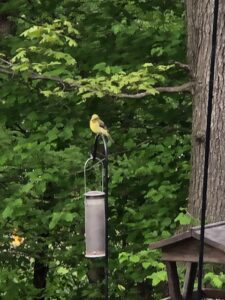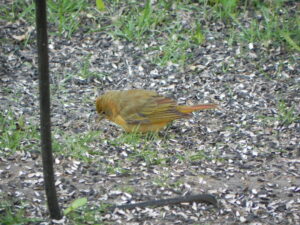by Winding Pathways | Oct 1, 2020 | (Sub)Urban Homesteading, Birds, Mammals, Nature
We’ll remember August 10, 2020, forever. On that day the wind changed Eastern Iowa and Winding Pathways in a way that will persist for a century. In 40 minutes, straight-line wind gusts up to 140 miles an hour toppled or broke 47 of our 53 trees. Two landed on our roof.
Our property adjoins Faulkes Heritage Woods, a 110-acre preserve of tall old trees, mostly oaks. The derecho felled most of its big trees that tumbled into a jumbled mass of trunks, branches, and leaves.
-
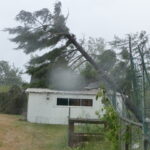
-
The pine toppled onto the cabin roof.
-
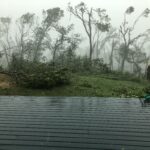
-
Effects of straight-line winds.
-
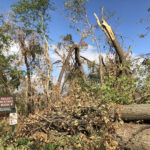
-
Twisted trees.
Wondering how the great change would impact wildlife, we quickly noticed two short term impacts. August and September are usually slow months for bird feeder visitors as birds normally have plenty of wild food. As soon as the wind calmed, all was still. Faithfully, Rich found and filled the feeders. The next morning, we noticed heavy use by house finches, titmice, nuthatches, cardinals, woodpeckers, and chickadees. It was almost like the feeding frenzy that happens as a winter blizzard approaches.
Short Term Impacts
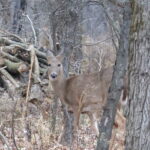
Trails are disrupted.
We quickly realized that deer, raccoons, coyotes, woodchucks, squirrels, and even chipmunks experienced a life-changing event. Their travel corridors changed as huge trees blocked deer trails, for example. They had to find new routes through the debris. One afternoon we saw a mother deer and fawn walking on the one remaining “open” trail around our prairie. Then, they crawled under a fallen tree and disappeared into the maze of branches. The ever clever raccoons have become more than pests as they tear up feeders and raid garbage cans. Also, the storm destroyed this year’s acorn and walnut crop, nuts that many species require. That is why the birds came so readily to the feeders. And still do!
-
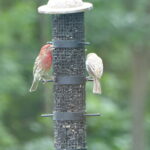
-
The house finches eat serenely.
-
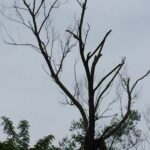
-
Even the crows come around to grab a snack.
-
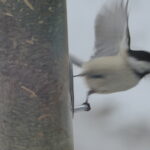
-
From early light to last dusk chickadees work the feeders.
Longer-Term Impacts
We are now watching for the long term impacts of the loss of so many trees. Our good friend, Jim Berry, is the former executive director of the Roger Tory Peterson Institute in New York. We asked him what we might expect following the loss of so many big trees in Faulkes Woods and our property.
“There are winners and losers. I would expect to see fewer wood thrushes, ovenbirds, and scarlet tanagers. They prefer mature forests. The more open woods and sunshine hitting the ground will cause an increase in cardinals, robins, and white-eyed vireos,” he said.
We have been fortunate to enjoy seven woodpecker species over the years. Some will benefit and some will lose from the great woods opening windstorm. According to Jim red-headed, red-bellied, and downy woodpeckers are likely to increase. So will flickers.
But sapsuckers and hairy and pileated woodpeckers that like the old trees and a closed canopy will probably decline.
-

-
The small mammals are hungry.
-
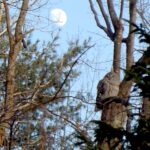
-
Owls will benefit from broken trees as cavities develop.
-
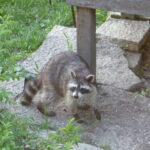
-
Raccoons ravage feeders at night.
The loss of hollow trees that shelter animals and the destroyed nut crop are going to make this a lean winter for squirrels. Deer, blue jays, woodchucks, chipmunks, and wild turkeys will also miss the acorns that normally rain down each fall.
We were saddened to lose so many trees but look forward to watching the forest restore itself. We’re also watching to see changes in wildlife.
by Winding Pathways | Aug 13, 2020 | (Sub)Urban Homesteading, Birds, Garden/Yard, Nature
This summer we enjoyed watching wren couples set up housekeeping at Winding Pathways. One pair nested in a small box under our porch ceiling, while another chose a box a few feet outside the dining room window.
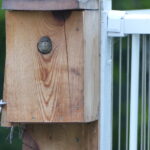
The world is big, bright and intriguing.
We watched these tiny, industrious birds make dozens of trips bringing sticks to make nests. Then, for a few weeks, we saw them infrequently. Only the female visited to lay eggs. Once her clutch was complete, she incubated them for a couple of weeks until they hatched. Then our fun began.
Wren parenting is hard work. Every two or three minutes one parent or the other brought juicy caterpillars and leggy bugs to feed the rapidly growing brood. Baby wrens hatch helpless and blind, but in just a couple of weeks, they grow almost as big as mom and dad. Finally, it’s time to fledge.
On the morning of August 9, we sat on the deck watching a young wren peer out the entrance hole, begging for breakfast. Mom or dad brought bugs, but mostly they urged the youngster, and its siblings, to take the plunge and abandon the only home they knew.
It’s scary. The nest is secure and safe. Mom and dad bring food and keep it clean. Then they expect their kids to leave and earn their own living in a world fraught with danger.
Our young wrens peered outside for a day or two before fluttering into the world. Huddling in low lying vegetation they called hungrily. Fortunately for wrens and many other birds, the adults help them out. We continued to hear these “branchers” calling in the nearby woods and caught glimpses of the parents bringing bugs to them. Slowly the babies figured it out.
After a few days, the young re-appeared around the yard, flying awkwardly. They have much to learn, and all sorts of perils to avoid. The parents continue to support them and many will wing south as the weather cools. We’ll watch for their return next April.
This year millions of American teenagers and new college grads are in the same fix as young wrens. Childhood and Youth are over. Peering out the door and knowing they must leave is scary. It’s tough enough to leave home during normal times, but this year coronavirus is making the transition extra challenging.
Young people heading for college don’t know whether classes will even be held. If so, will they be online or in-person? Will college include exposure to a virus that could sicken or kill? Recent high school and college grads seeking a job face different challenges. High unemployment and lurking viruses can make finding work difficult and, perhaps, dangerous. Join the military? Move across the country for a job? That’s perilous, also. Nothing seems safe. Everything’s confusing.
Like the young wrens, parents still help guide their offspring, providing support, advice, and encouragement as the “young” leave the nest. We send good wishes to the youthful wrens that started life at Winding Pathways and to young people about to launch into a confusing and challenging world. May they all thrive.
-
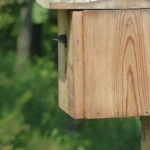
-
This baby is checking out the scenery.
-
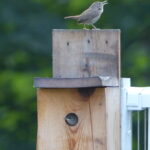
-
Parent encourages the baby.
-
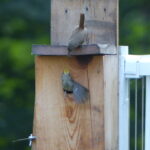
-
The parent dangles tasty morsels, forcing the baby to come outside the nest box.
-
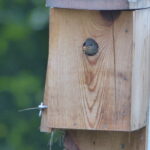
-
This huge bug is a mouthful!
-
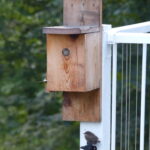
-
A short first flight.
-
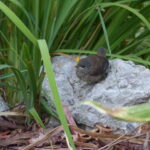
-
This wren fluttered to the ground below the next box.
by Winding Pathways | Jul 23, 2020 | (Sub)Urban Homesteading, Birds, Garden/Yard, Nature
Chickadee Delight
Guest Blogger Jackie Hull
There is nothing that can surpass the natural ebb and flow of life passing by one’s window every day. The early morning symphony of spring birds creating their own composition of sound as each species awakens to another day. The goldfinches, chipping sparrows, Indigo buntings, robins, flickers, wood thrushes, chickadees, pileated woodpecker, nuthatches, downy and hairy woodpeckers, crows, hawks, catbirds and the unflappable mockingbird all announcing to the world that it’s a new day. Up and at ‘em!”
Grand Symphony
One particular morning after this grand symphony I noticed a chickadee zip into the mimosa tree near the back door. As he teetered on a branch, he seemed to be checking out the birdhouse attached to the side picket fence that surrounds our cottage garden. The chick came in for a closer look as he landed securely on a fence post. Then straight as an arrow, he went through the birdhouse entry for the final inspection.
Apparently the abode met with approval. Soon the male and female chickadees were padding the floor of the birdhouse with moss from the woods across the pasture. Diligently they flew to and from the woods with beaks full of moss. At one point my curiosity coaxed me to peek inside the box to view their progress. The moss-covered the floor and they had begun twining fine grass strands into a circle. One of the chickadees caught me and scolded me soundly for peeking.
Mid-Day Lull

Taking wing
Mid-day that there didn’t seem to be much activity. As soon as the sun began setting, the chicks stepped up their construction. Again my curiosity pushed me to the birdhouse. I opened the door. To my complete delight, I counted six cream-colored eggs with soft brown speckles nestled in a perfectly round cup of grass. Of course, the chicks caught me again and proceeded with another scolding. I retreated to the back step.
Every day I waited impatiently for the hatching. The male came regularly with worms to share with the mate. He would give a clear whistle and then softly chat before he popped into the house. It seemed to me that this breeding process was taking too long. Once more I peeked. Six chicks opened wide their beaks and begged for food. This seemed like the last straw to the doting parents. They clamored about chattering at me. Again I retreated and watched from the back step.
Frantic Fledging
This preparing the chicks for fledging began at dawn and continued until dusk, quite a marathon. First, one adult came with beautiful green worms to be popped into the loudest mouth. The adults always announced that they were coming as they hopped from crepe myrtle to post and always bull’s eyed the doorway. As quickly as they entered, they were gone to forage for more bugs and worms.
One morning several weeks later I noticed a chick teetering in the doorway. The chick quickly retreated because that nosy woman was at the back door again. Sensing I was on the inside looking out, he hopped onto the door lip. Within a matter of minutes, he flew out the doorway, trying desperately to cling to the slippery vinyl house siding. In a twinkling of an eye, one of the adults was there to guide the fledgling to the butterfly bush. The chicks’ tail feathers were a bit short, but using every ounce of energy, the chick followed the adult across the yard into the wild rose bush.
Appreciation of Little Moments
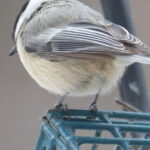
Chickadees grasp suet feeders
This was certainly a morning of the natural ebb and flow of life. If I decided to leave the back doorway, that moment would have passed me by forever. Such a glorious moment I would have missed. Within three hours the other chicks had flown away following their parents into the woods further down the lane. I could hear them chattering to the chicks and the chicks answering them. They have gone on now leaving me to ponder the wonder of life. It was a special event to have had this chickadee pair decide it was just fine to nest so near my back door.
I will always cherish the sheer joy it gave to me.
by Winding Pathways | Jun 25, 2020 | Birds, Garden/Yard, Nature
She feeds ’em. I shoot ’em.
Guest Bloggers STB
Yes, this sounds like a love/hate relationship. But, it is truly pure enjoyment for my wife and me to witness the birds that visit our backyard feeder here in SE Minnesota.
Throughout the year a variety of birds comes from the woods to feast at my wife’s feeder. From late April to early May the orioles make their appearance. Baltimore Orioles have a vivid bright orange color and the Orchard Oriole has a noticeably darker burnt orange color. The recent reality of retirement has allowed us more time for photography and our birds have become a passion.
Capturing a static image of a perched bird is relatively easy but my goal has been to catch them in their interactions and flight. Shutter speeds of 1/1000th of a second or faster are recommended and patience is mandatory but the results might get you hooked. Beware…
-
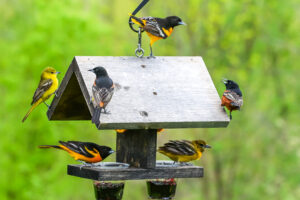
-
The jelly attracts the orioles.
-
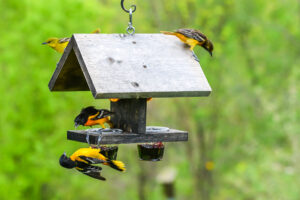
-
Sparring over rights to the jelly.
-
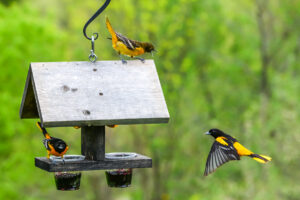
-
Warding off the in-coming oriole.
by Winding Pathways | Jun 18, 2020 | Birds, Garden/Yard, Nature
Another beautiful, blue-sky day. This early morning I am drinking tea and looking out the patio windows. As I enjoy the view of the freshly cut lawn and watch the birds flit about, a bit of busy-ness above the deck catches my attention. A small, loose clump of grey moss trembles and jerks around. It seems suspended like a little tube sock from a maple branch.
A tiny head and two bright eyes appear. In a wink, she’s gone. Moments later, another flash, this time with a hint of yellow. More trembling and jerking around, on the branch. And now I’m sure we have a nesting pair in our tree at the end of the deck.
Despite the yellow, her beak is too long and slender to be a goldfinch. A burst of warbling and I think it might be ‘Mistress Mary’, one of my favourite songbirds that keeps me company on long summer afternoons.
I can look forward to hours of entertainment.
Mistress Mary is just my name for a songbird whose phrases sound like an event organizer ordering people around:
“Jay-jay, sorry, Jo-Jo, sit here.”
“That’s your story?
“So?”
“Bring it here.”
“Will you do it?”
“Where are you?”
“Do ya think?”
She has quite a repertoire of a dozen or so phrases that she repeats faithfully. Fun to listen to. I first heard her about five years ago.
The Hermit thrush has also arrived in Eastern Canada for his summer stay. His ethereal song echoes in the woods.
Readers, scroll through the article in the New York Times to read an interesting article interspersed with bird sounds: Hear 13 Birds Flourishing in a Newly Quiet New York (City).
by Winding Pathways | Jun 11, 2020 | Birds, Garden/Yard, Nature
We’re lucky. Scarlet tanagers nest near us. Winding Pathways abuts Faulkes Heritage Woods, a protected 110-acre forest of mostly monstrous oak trees. So, every May we’re delighted as this brilliant bird arrives and sets up home.
Male scarlet tanagers appear at our feeders in mid-May. Females come a few days later. The male’s amazingly brilliant red feathers and contrasting black wings make the bird unmistakable. For only a week or two they visit the orange-colored suet we set out and pick sunflower seeds from silo feeders. Then they disappear. We knew they abandoned our yard to nest near the tops of big oaks in the nearby woods, but they are very hard to spot there, even as they sally forth to catch insects from mid-air catching a meal. Their summer diet is mostly insects.
-
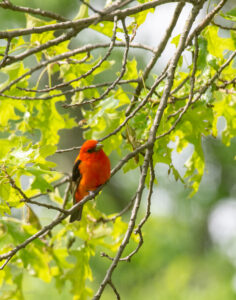
-
The male scarlet tanager arrives. several days ahead of the female.
-
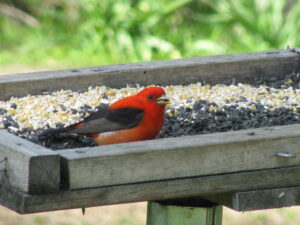
-
The tanagers willinging come to the platform feeder.
We wondered where they went after nesting and consulted our friend Jim Berry, retired executive director of the Roger Tory Peterson Institute in Jamestown, New York. Here’s what he wrote:
“Once the baby birds fledge, familial responsibilities end and the birds move away from forests to places where they can find food and molt. Often these are old fields and marshes, where they seem to disappear. This is called the post-season dispersal.
They soon replace their brilliant red feathers with duller-colored new ones that help them migrate.”
Jim told us we are lucky to have scarlet tanagers come to our feeders. They don’t where he lives in Western New York.
After they molt the birds fly all the way to northwestern South America for the winter. We won’t see them again until next May.
These are breathtakingly beautiful birds that brighten our yard for just a short while each year. We’re humbled to be able to host them.

























